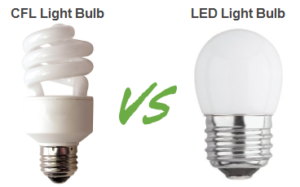 In a previous post we compared the ROI for LED lights vs. incandescent light bulbs. LED’s although they are very expensive can last for up to 50,000 hours and save a great deal of money over their life time compared to incandescent bulbs even though they are much less expensive. The other question we wanted to look at is how to LRD bulbs compare to CFL’s(Compact fluorescent Light bulbs) and should we invest in one or the other at this time.
In a previous post we compared the ROI for LED lights vs. incandescent light bulbs. LED’s although they are very expensive can last for up to 50,000 hours and save a great deal of money over their life time compared to incandescent bulbs even though they are much less expensive. The other question we wanted to look at is how to LRD bulbs compare to CFL’s(Compact fluorescent Light bulbs) and should we invest in one or the other at this time.
We found one such study, which actually showed that they were pretty close in the total savings, when you compare them both over a 50,000 hour time span. CFL’s cost around $4 a piece while LED’s cost around $35 at this time per bulb. CFL’s last for 10,000 hours so you will need five bulbs to cover the 50,000 hours. Both are very efficient, although LED’s have a slight lead over the CFL’s.
Comparison of Savings for LED’s vs. CFL’s
The actual savings of the LED’s was about $4 over the 50,000 hours when comparing to CFL’s. Both of these bulbs save a great deal more when compared to incandescent bulbs. Total savings for the CFL bulb was $263 compared to the savings of $267 for the LED bulbs.
The conclusion from this comparison is that when a CFL does finally burn out, consumers would be wise to install LED’s in their lamps with the following conditions taken into consideration:
The light will be used for more than 3 hours a day, which should last 10 years at this rate
- You are planning on staying in the home for a long period of time
- You want to upgrade your lights as part of a sales incentive when selling your home
- Otherwise, CFL’s would be more than sufficient and reduce your initial installation cost.
An Example of When to Use LED Light Bulb Canada
As an example we plan to stay in our home for longer than 10 years. We have four lights that are on all night, which is approximately 10 hours a day. These lights would be ideal candidates for LED’s. We have several lamps that are also on for roughly 5 hours an evening depending on the time of year. These lamps could also be equipped with LED’s. Although if we were moving in less than 5 years, I probably would install CFL’s, just to minimize the initial cost. Other lights in the house which are not used as often would have CFL’s installed. Again this is to minimize the cost taking into account these lights are only used a few hours a week.
If you still have incandescent light bulbs installed in your home, the savings are so significant in terms of reduced electrical usage, that it makes sense to install CFL’s or LED’s even before they burn out following the above guidelines that we have outlined.
LED’s Decreasing in Price
As the price for LED’s decrease based on volume production, these recommendations may change and instead of installing CFL’s in lamps that are not used that often, it will just make sense to install LED’s everywhere. Unfortunately we are not at that point yet since the cost of LED’s is still pretty high. We are not sure if the price is based on cost or perceived value to the consumer. LED’s last up to 5 times longer than CFL’s and the prices are about 8 times more expensive. Based on this we think there is still a premium compared to the LED’s however that will decrease over time.
Consumers should monitor the prices and when they are down to approximately $20 for a LED bulb, there is no longer any premium on the LED’s. This will happen over time, especially as demand goes up, governments provide incentives and mass production sets in.
Let us know if this information was useful and if you also have additional thoughts and guidelines that should be considered when using LED light bulbs in Canada or the USA for residential use.
For more posts about LED lights and saving energy, click here.